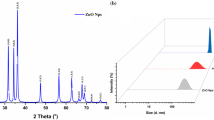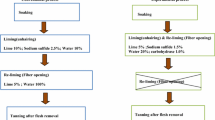Abstract
The conventional unhairing process in leather making utilises large amount of lime and sodium sulphide which is hazardous and poses serious waste disposal concerns. Under acidic conditions, sodium sulphide liberates significant quantities of hydrogen sulphide which causes frequent fatal accidents. Further, the conventional unhairing process involves destruction of the hair leading to increased levels of biological oxygen demand (BOD), chemical oxygen demand (COD), total dissolved solids (TDS) and total suspended solids (TSS) in the effluent. A safe approach is needed to overcome such environmental and health problems through an eco-benign process. The present study deals with a clean technology in which the keratinous body is detached from the dermis using enzymes produced from Bacillus crolab MTCC 5468 by solid state fermentation (SSF) as an alternative to noxious chemicals. Complete unhairing of skin could be achieved with an enzyme concentration of 1.2 % (w/w). The bio-chemical parameters of the spent liquor of the enzymatic process were environmentally favourable when compared with conventional method. The study indicates that the enzymatic unhairing is a safe process which could be used effectively in leather processing to alleviate pollution and health problems.




Similar content being viewed by others
References
Alessandro R, Silvia O, Adriano B (2003) Dehairing activity of extracellular protease produced by keratinolytic bacteria. J ChemTechnol 78:855–859
Aly AS, Moustafa AB, Hebeish A (2004) Bio-technological treatment of cellulosic textiles. J Clean Prod 12:697–705
Andrioli E, Petry L, Gutterres M (2015) Environmentally friendly hide unhairing: enzymatic-oxidative unhairing as an alternative to use of lime and sodium sulfide. Process Saf Environ 93:9–17
Anson ML (1938) The estimation of pepsin, trypsin, papain, and cathepsin with hemoglobin. J Gen Physiol 22:79–89
Bancroft JD, Gamble M (2004) Theory and practice of histological techniques. In: Jones ML, Totty BA (Eds) Connective tissues and stains, 15thedn. Churchill Livingstone Publications, p 139–200
Beynon J, Bod JS (1989) Proteolytic enzymes, a practical approach. IRL press, New York
Cantera CS, Angelinetti AR, Altobelli G, Gaita G (1996) Hair saving enzyme—assisted unhairing: influence of enzymatic products upon final leather quality. J Soc leather Technol Chem 80:83–86
Clesceri LS, Greenberg AE, Trussell RR (eds) (1989) Standard methods for the examination of water and wastewater, 17thedn. American public health association, Washington, DC
Dayanandan A, Kanagaraj J, Sounderraj L, Rajkumar GS (2003) Application of an alkaline protease in leather processing: an eco-friendly approach. J Clean Prod 11:533–536
IUC 8 (1998) Determination of chromic oxide content. J Soc Leather Technol Chem 82:200–208
IUP 2 (2000) Sampling. J Soc Leather Technol Chem 84:303–309
IUP 6 (2000) Measurement of tensile strength and percentage elongation. J Soc Leather Technol Chem 84:317–321
Kanth SV, Venba R, Madhan B, Chandrababu NK, Sadulla S (2009) Cleaner tanning practices for tannery pollution abatement: role of enzymes in eco-friendly vegetable tanning. J Clean Prod 17:507–515
Kandasamy N, Velmurugan P, Sundarvel A, Jonnalagadda RR, Bangaru C, Palanisamy T (2012) Eco- benign enzymatic dehairing of goat skins utilizing a protease from Pseudomonas fluorescens species isolated from fish visceral waste. J Clean Prod 25:27–33
Kumar VE, Srijana M, Kumar K, Harikrishna N, Reddy G (2011) A novel serine alkaline protease from Bacillus altitudinis GVC11 and its application as a dehairing agent. Bioproc Biosyst Engg 34:403–409
Kunitz M (1947) Crystalline soybean trypsin inhibitor. J Gen Physiol 30:291–231
Lowry OH, Rosebrough NJ, Farr AL, Randall RJ (1951) Protein measurement with the Folin phenol reagent. J Bio Chem 193:265–273
Mahmoodi NM, Arami M, Mazaheri F, Rahimi S (2010) Degradation of sericin (degumming) of Persian silk by ultrasound and enzymes as a cleaner and environmentally friendly process. J Clean Prod 18:146–151
Malathi S, Dhar SC (1987) Production of extracellular proteases by an Aspergillus flavus isolate and its application in the depilation of skins. Leather Sci 34:67–76
Mclaughin GD (1945) Thesis E.B. the Chemistry of Leather Manufacture. Reinhold Publishing Corp, New York
Nancy G, Prakram SC, Vivek K, Neena P, Naveen G (2014) Approach to eco-friendly leather: characterization and application of an alkaline protease for chemical free dehairing of skins and hides at pilot scale. J Clean Prod 79:249–257
Nilegaonkar SS, Zambare VP, Kanekar PP, Dhakephalkar PK, Sarnaik SS (2007) Production and partial characterization of dehairing protease from Bacillus cereus MCM B-326. Bioresour Technol 98:1238–1245
Palanisamy T, Jonnalagadda R, Balachandran U, Thirumalachari R (2004) Process and recent trends in biotechnological application methods for leather processing. Trends Biotechnol 22:181–188
Paul RG, Mohamed I, Davighi D, Covington AD, Addy VL (2001) The use of neutral protease in enzymatic unhairing. J Am Leather Chem Ass 96:180–185
Saravanabhavan S, Thanikaivelan P, Rao JR, Nair BU (2005) Silicate enhanced enzymatic dehairing: a new lime-sulphide-free process for cowhides. Environ Sci Techno l39:3776–3783
Valeika V, Beleska K, Valeikiene V, Kolodzeiskiset W (2009) An approach to cleaner production: from hair burning to hair saving using a lime-free unhairing system. J Clean Prod 17:214–222
Vijayaraghavan P, Lazarus S, Vincent SGP (2014) De-hairing protease production by an isolated Bacillus cereus strain AT under solid-state fermentation using cow dung: Biosynthesis and properties. Saudi J Biol Sci 21:27–34
Wang SL, Hsu WT, Liang TW, Wang CL (2008) Purification and characterization of three novel keratinolytic metalloproteases produced by Chryseobacterium indologenes TKU14 in a shrimp shell powder medium. Bioresour Technol 99(13):5679–5686
Zhu Y, Huang W, Ni J (2010) A promising clean process for production of diosgenin from Dioscorea zingiberensis C. H. Wright. J Clean Prod 18:242–247
Acknowledgment
The authors gratefully acknowledge the Council of Scientific and Industrial Research (CSIR), New Delhi for funding this research and are thankful to the Director, CSIR—Central Leather Research Institute for his support. The authors also thank “Science and Technology Revolution in Leather with a Green Touch” (STRAIT)—1180.
Author information
Authors and Affiliations
Corresponding authors
Additional information
Responsible editor: Philippe Garrigues
Rights and permissions
About this article
Cite this article
Ranjithkumar, A., Durga, J., Ramesh, R. et al. Cleaner processing: a sulphide—free approach for depilation of skins. Environ Sci Pollut Res 24, 180–188 (2017). https://doi.org/10.1007/s11356-016-7645-6
Received:
Accepted:
Published:
Issue Date:
DOI: https://doi.org/10.1007/s11356-016-7645-6




